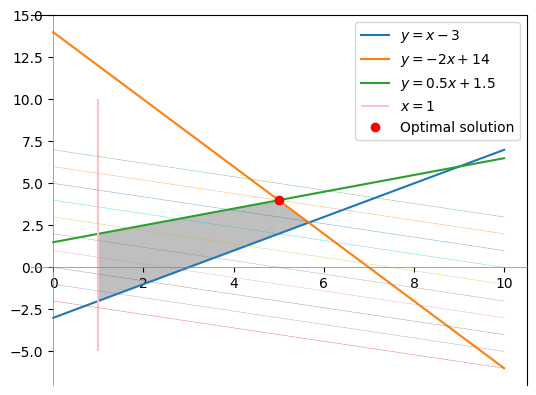Problem 2.1#
Integrated Energy Grids
Problem 2.1
Given the following optimization problem,
a) Solve the optimization problem graphically (pen and paper or on your laptop). Note that it is a maximization problem, whereas we will mostly work with minimizations. Reformulate as a minimization problem.
b) Return to the original formulation. Indicate which constraints are binding and calculate the values of the Lagrange multipliers.
c) In the above set-up, we have a unique solution to our maximization problem (existence and uniqueness). Adapt the exercise such that this is no longer the case.
a)
We will use numpy to operate with arrays and matplotlib.pyplot to plot the results. We also use linopy to solve linear problems and work with pandas to work with dataframes.
import pandas as pd
import numpy as np
import linopy
import matplotlib.pyplot as plt
We define the constraints, and rewrite them in the form y = mx + b. For plotting purposes, we define an evenly spaced sample of the x-values.
x = np.linspace(0, 10, 100)
y0 = x - 3
y1 = -2*x + 14
y2 = 0.5*x + 1.5
# The following will make it easier to fill the area of the feasible space in the graphical solution.
con0 = lambda a: a - 3
con1 = lambda a: -2*a + 14
con2 = lambda a: 0.5*a + 1.5
We will also plot different level sets of the objective function.
fig, ax = plt.subplots()
# Plot the inequalities
ax.plot(x, y0, label=r'$y = x - 3$')
ax.plot(x, y1, label=r'$y = -2x + 14$')
ax.plot(x, y2, label=r'$y = 0.5x + 1.5$')
# Add the constant function
ax.vlines(x=1, ymin=-5, ymax=10, label = r'$x = 1$', color='pink')
# Fill feasible region
z1 = np.linspace(1,5,40)
z2 = np.linspace(5,17/3,40)
ax.fill_between(z1, con0(z1), con2(z1), color='gray', edgecolor=None,alpha=0.5)
ax.fill_between(z2, con0(z2), con1(z2), color='gray', edgecolor=None,alpha=0.5)
# Plot different level sets of obj.
#opt_val = 30
for val in range(-10, 40, 5):
y = (val - 2*x)/5
ax.plot(x, y, ls='--', lw=0.3)
# Plot the optimal solution
ax.plot(5, 4, 'ro', label='Optimal solution')
# Plot the obj
ax.legend();
# Plot the coordinate system
ax.spines['left'].set_position('zero')
ax.spines['left'].set_color('gray')
ax.spines['left'].set_linewidth(0.5)
ax.spines['bottom'].set_position('zero')
ax.spines['bottom'].set_color('gray')
ax.spines['bottom'].set_linewidth(0.5)

We can write the problem as a minimization problem as follows:
b)
Set up the problem in linopy:
# For reference:
m21 = linopy.Model()
# Add the variables.
x = m21.add_variables(lower=0,name="x")
y = m21.add_variables(lower=0,name="y")
# Add the constraints and note the sense of the inequality.
m21.add_constraints(-x + y >= -3)
m21.add_constraints(2*x + y <= 14)
m21.add_constraints(-0.5*x + y <= 1.5)
m21.add_constraints(x >= 1)
# Add the objective function and specify it as a maximization problem.
m21.add_objective(2*x + 5*y, sense = "max")
# Solve the maximization problem.
m21.solve(solver_name="gurobi")
m21.solution
Restricted license - for non-production use only - expires 2026-11-23
Read LP format model from file /tmp/linopy-problem-uc739k2k.lp
Reading time = 0.00 seconds
obj: 4 rows, 2 columns, 7 nonzeros
Gurobi Optimizer version 12.0.2 build v12.0.2rc0 (linux64 - "Ubuntu 24.04.2 LTS")
CPU model: AMD EPYC 7763 64-Core Processor, instruction set [SSE2|AVX|AVX2]
Thread count: 2 physical cores, 4 logical processors, using up to 4 threads
Optimize a model with 4 rows, 2 columns and 7 nonzeros
Model fingerprint: 0x10c518a0
Coefficient statistics:
Matrix range [5e-01, 2e+00]
Objective range [2e+00, 5e+00]
Bounds range [0e+00, 0e+00]
RHS range [1e+00, 1e+01]
Presolve removed 1 rows and 0 columns
Presolve time: 0.00s
Presolved: 3 rows, 2 columns, 6 nonzeros
Iteration Objective Primal Inf. Dual Inf. Time
0 6.2000000e+01 8.497000e+00 0.000000e+00 0s
1 3.0000000e+01 0.000000e+00 0.000000e+00 0s
Solved in 1 iterations and 0.01 seconds (0.00 work units)
Optimal objective 3.000000000e+01
<xarray.Dataset> Size: 16B
Dimensions: ()
Data variables:
x float64 8B 5.0
y float64 8B 4.0Print the duals of the optimization problem
m21.dual
<xarray.Dataset> Size: 32B
Dimensions: ()
Data variables:
con0 float64 8B 0.0
con1 float64 8B 1.8
con2 float64 8B 3.2
con3 float64 8B 0.0c)
Different ways of changing the problem so it no longer has a unique solution:
make it infeasible (e.g. add a constraint \(y \geq 4.1\))
remove uniqueness (e.g. change the objective function to be \(min_{x,y} x\)), get more than one unique solution along the edge in \(x=1\).

